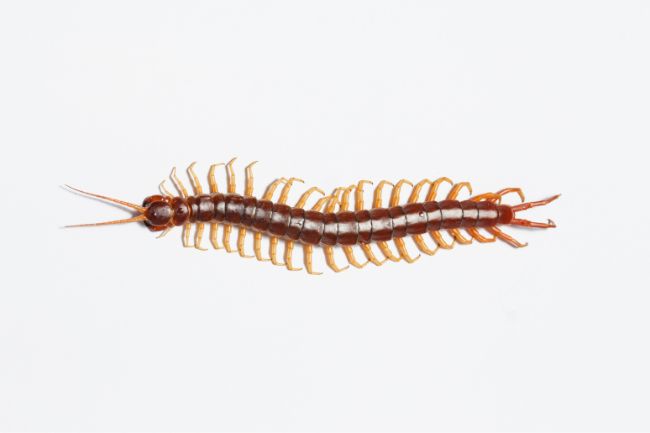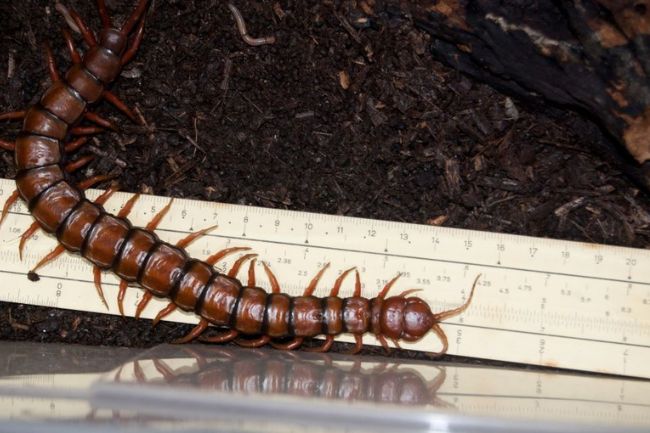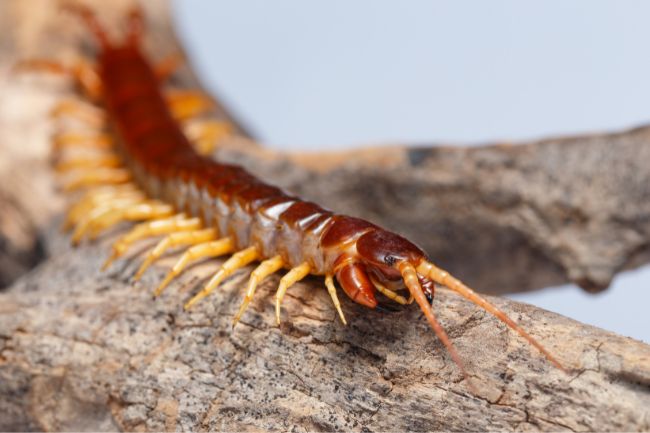Centipedes can climb up walls, due to small hooks at the end of their legs. However, they tend to prefer to spend their time in damp places, such as under rocks or in the soil.
Contents
Can centipedes climb up walls?

Across the world, there are more than 3,000 species of centipedes, which live across all continents apart from Antarctica. In these locations, they have adapted to thrive in many different habitats, including in rainforests and deserts.
In many of the places where these animals live, humans have also built their homes and workplaces. These may be buildings made of brick or wood, those that are sealed shut and air-conditioned, or those that are open to the elements.
In many countries, centipedes may accidentally, or on purpose, find themselves confronted by human-made structures. When this occurs, they have a choice, to turn back or go up. Luckily for them, centipedes are able to scale most vertical surfaces, including walls.
When we look at animals climbing up, what seem to us to be sheer vertical walls, it can appear like something out of science fiction. Yet, these antigravity stunts are not quite as miraculous as they seem.
| Surface | Description |
|---|---|
| Walls | Centipedes can climb vertical surfaces such as walls using their leg grip. |
| Ceilings | Some centipede species are capable of climbing and moving across ceilings. |
| Furniture | Centipedes can navigate furniture like cabinets, bookshelves, and tables. |
| Plant stems | Thin and flexible plant stems provide climbing opportunities for centipedes. |
| Tree trunks | Centipedes may climb trees to search for prey or seek shelter. |
| Rocks and stones | Rough surfaces like rocks and stones offer grip for climbing centipedes. |
| Twigs and branches | Centipedes can scale small branches and twigs in search of food or shelter. |
In the end, it all comes down to scale. If you take a hand lens, or other magnifying glass, and look closely at your wall, or other sheer surfaces, you will find there are many tiny lumps and bumps across the surface. These tiny crags and ledges may be too small for us to hold on to, but for smaller creatures, they are just what they need to scale the heights they need to reach.
How they do this varies between different species of animals. Some animal use types of suckers, to essentially glue themselves to the surface. Others may have little hooks that act almost like Velcro, attaching in to tiny crevices.

When it comes to centipedes, it’s hard to see where they might hide such wall-scaling apparatus, yet they too have something up their sleeves, or at least at the end of their legs.
Centipedes are well known for their ‘hundreds’ of little legs. In fact, the number of legs varies massively between different species. It can be as few as ten, or as many as three hundred. At the end of these legs, centipedes have little hooks. These hooks are ideal for grasping onto a knobbly surface.
While they may not be attached to the wall by any other means, the number of legs they possess helps them to hang on. They also have clever adaptations to stop them from tripping themselves up, with each set of legs being longer than the one before it, and there being no point when all legs are off the ground at the same time.
Also read: Centipedes Life Span: How Long do They Live?
Can centipedes climb up beds?

Just like walls, centipedes can quite happily scale most materials that beds are often made out of. For example, wood, a common material for beds, has an inherently textured surface, even when it has been smoothed to a fine finish. There are therefore generally enough small indentations for a centipede to make its way up.
Not all surfaces are easy for centipedes to climb. Polished metal, or glass, for instance, maybe too slippery to get a good hold on. Of course, if the bedsheets are drooping down to the ground, these may also make a handy pathway.
Also read: Centipedes in Winter: What Happens With Them? Do They Like it?
| Risks | Description |
|---|---|
| Nuisance | Centipedes climbing indoors can be perceived as a nuisance by residents. They may appear in unexpected areas like bathrooms or basements. |
| Bite potential | Increased chances of accidental centipede bites when handling objects. Centipedes may bite if they feel threatened or cornered. It’s important to exercise caution when encountering them. |
| Indoor infestation | Centipede presence indoors may indicate an underlying pest infestation. They are often attracted to dark, damp areas and can coexist with other pests like spiders or insects. |
| Allergen trigger | Individuals with centipede allergies may experience allergic reactions when exposed to centipede secretions or bites. Symptoms can include itching, redness, or swelling. It’s advisable to seek medical attention if an allergic reaction occurs. |
Do centipedes prefer climbing or crawling?
We are often pretty unnerved at the idea of creepy crawlies making their way into our homes, and particularly our beds, but in general most species have little interest in exploring our living quarters.
Centipedes, in particular, are animals that like dark and damp places. This is because they dry out easily in the sun and heat, and they need to stay moist, so they do not dehydrate. Modern human homes are generally too dry and bright for animals like centipedes, and often do not have enough food to provide them with a suitable hunting ground.
The exception may be more traditional homes within hot and humid areas, where the inside of the house may be open to the elements, allowing centipedes to wander in and out at will. Even in modern homes, centipedes may wander in by accident, though they will usually opt to leave as quickly as possible.
| Adaptation | Description |
|---|---|
| Leg grip | Centipedes have specialized leg structures with hooked claws that allow them to grip onto various surfaces. |
| Flexibility | Their elongated and flexible bodies enable them to maneuver through tight spaces and crevices. |
| Quick movement | Centipedes can move swiftly, utilizing their agile legs to climb and explore their environment. |
| Sensory perception | They possess sensory organs called antennae that help them detect and navigate their climbing surfaces. |
Aside from liking damp places, centipedes also generally prefer spending most of their time crawling and tunnelling, rather than clambering up walls. For many species, their preferred habitat is within the soil, or crawling into crevices in rocks or rotten wood. Climbing up in exposed places, such as the surface of walls, leaves them out in the open and vulnerable to predators. They are most likely to choose this kind of route when they see little alternative.
So while centipedes could climb up your walls or trundle into your bed, most of the time they are much happier burrowing around in the leaf litter in your garden. And if one does accidentally get stuck in your house, the best thing you can do is safely return it to the outside. It’s a busy little creature, after all, with much more important things to do than inspect the corners of your rooms for dust and spiderwebs.
Also read: Do Garden Spiders Come Into The House? (Hiding Places)

